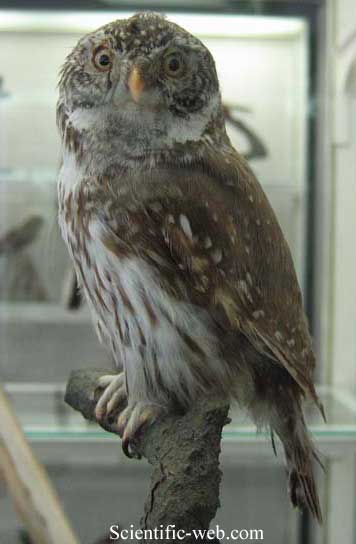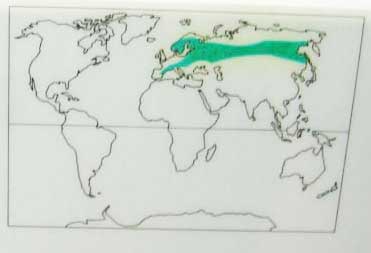
Glaucidium passerinum, Photo: Michael Lahanas
Superregnum: Eukaryota
Cladus: Unikonta
Cladus: Opisthokonta
Cladus: Holozoa
Regnum: Animalia
Subregnum: Eumetazoa
Cladus: Bilateria
Cladus: Nephrozoa
Superphylum: Deuterostomia
Phylum: Chordata
Subphylum: Vertebrata
Infraphylum: Gnathostomata
Megaclassis: Osteichthyes
Cladus: Sarcopterygii
Cladus: Rhipidistia
Cladus: Tetrapodomorpha
Cladus: Eotetrapodiformes
Cladus: Elpistostegalia
Superclassis: Tetrapoda
Cladus: Reptiliomorpha
Cladus: Amniota
Classis: Reptilia
Cladus: Eureptilia
Cladus: Romeriida
Subclassis: Diapsida
Cladus: Sauria
Infraclassis: Archosauromorpha
Cladus: Crurotarsi
Divisio: Archosauria
Cladus: Avemetatarsalia
Cladus: Ornithodira
Subtaxon: Dinosauromorpha
Cladus: Dinosauriformes
Cladus: Dracohors
Cladus: Dinosauria
Ordo: Saurischia
Cladus: Eusaurischia
Subordo: Theropoda
Cladus: Neotheropoda
Cladus: Averostra
Cladus: Tetanurae
Cladus: Avetheropoda
Cladus: Coelurosauria
Cladus: Tyrannoraptora
Cladus: Maniraptoromorpha
Cladus: Maniraptoriformes
Cladus: Maniraptora
Cladus: Pennaraptora
Cladus: Paraves
Cladus: Eumaniraptora
Cladus: Avialae
Infraclassis: Aves
Cladus: Euavialae
Cladus: Avebrevicauda
Cladus: Pygostylia
Cladus: Ornithothoraces
Cladus: Ornithuromorpha
Cladus: Carinatae
Parvclassis: Neornithes
Cohors: Neognathae
Cladus: Neoaves
Ordo: Strigiformes
Familia: Strigidae
Subfamilia: Surniinae
Genus: Glaucidium
Species: Glaucidium passerinum
Subspecies: G. p. orientale – G. p. passerinum
Name
Glaucidium passerinum (Linnaeus, 1758)
Synonymy
Strix passerina (protonym)

References
Linnaeus, C. 1758. Systema Naturae per regna tria naturae, secundum classes, ordines, genera, species, cum characteribus, differentiis, synonymis, locis. Editio Decima, Reformata. Tomus I. Holmiæ (Stockholm): impensis direct. Laurentii Salvii. 824 pp. DOI: 10.5962/bhl.title.542 BHL p. 93 BHL Reference page.
Vernacular names
العربية: بومة قزمة أوراسية
башҡортса: Һаҡ
беларуская (тарашкевіца): Сыч вераб’іны
беларуская: Сыч вераб’іны
български: Врабчова кукумявка
brezhoneg: Kaouenn gorr Eurazia
català: Mussolet eurasiàtic
čeština: Kulíšek nejmenší
чӑвашла: Çерçи тăмани
Cymraeg: Cordylluan
dansk: Spurveugle
Deutsch: Sperlingskauz
Ελληνικά: Σπουργιτόγλαυκα
English: Eurasian Pygmy Owl
Esperanto: Paserstrigo
español: Mochuelo chico
eesti: Värbkakk
euskara: Mozolo txiki
فارسی: جغد پیگمی اوراسیایی
suomi: Varpuspöllö
français: Chevêchette d'Europe
Gaeilge: Mionulchabhán Eoráiseach
galego: Moucho pequeno
hrvatski: Mali ćuk
magyar: Európai törpekuvik
italiano: Civetta nana
日本語: スズメフクロウ
ქართული: ბუკნაჭოტი
қазақша: Торғайдай байғызша
коми: Дзоля сюзь
lietuvių: Žvirblinė pelėda
latviešu: Apodziņš
монгол: Буслаг сүлиг
Nederlands: Dwerguil
norsk nynorsk: Sporveugle
norsk: Spurveugle
polski: Sóweczka zwyczajna
português: Mocho-pigmeu
русский: Воробьиный сыч
саха тыла: Лэкээрик мэкчиргэ
davvisámegiella: Cihceskuolfi
slovenčina: Kuvičok vrabčí
slovenščina: Mali skovik
српски / srpski: Мала сова
svenska: Sparvuggla
українська: Сичик-горобець
中文: 花头鸺鹠
The Eurasian pygmy owl (Glaucidium passerinum) is the smallest owl in Europe. It is a dark reddish to greyish-brown, with spotted sides and half of a white ring around the back of the neck.[3] This species is found in the boreal forests of Northern and Central Europe to Siberia.[3]
This is a sedentary species, meaning that adults are resident throughout the year in its range. The exception may be during harsh winters, when the adults may move south. Young of the species usually move in autumn or winter.[3]
Taxonomy
The Eurasian pygmy owl was formally described by the Swedish naturalist Carl Linnaeus in 1758 in the tenth edition of his Systema Naturae under the binomial name Strix passerina.[4] The type locality is Sweden.[5] The specific epithet is from Latin passerinus meaning "sparrow-like" implying "sparrow sized".[6] This owl is now placed in the genus Glaucidium that was introduced in 1826 by the German zoologist Friedrich Boie.[7][8]
Two subspecies are recognised:[8]
G. p. passerinum (Linnaeus, 1758) – central, north Europe to southwest Siberia
G. p. orientale Taczanowski, 1891 – central, east Siberia, Mongolia and northeast China
Description
The Eurasian pygmy owl is usually red-tinged to a greyish-brown with dots on its back. The tail is generally darker than the body with five narrow, whitish bars. It has a small, short head with white to grey eyebrows and yellow eyes. It lacks the ear tufts that many other owls have. There is a white half collar on the back of the neck. The belly is mostly white with brown speckles. The beak is a greyish yellow and hook-shaped.
In order to be able to carry larger vertebrate prey, it has evolved disproportionately large feet. The legs and toes are a brownish-yellow with black talons. Females are 17.4 to 19 centimetres (6.8 to 7.5 inches) long, and males are generally smaller, measuring 15.2 to 17 centimetres (6 to 6.7 inches) in length. Females are about 67 to 77 grams, and males are 50 to 65 grams in weight.
Vocalisation
The call of the Eurasian pygmy owl is much higher in pitch than what is generally perceived as a normal owl "hoot". The call of the male is a monotonous chain of clear, fluted notes spaced by about two seconds. The call of the female is similar, but higher in pitch. Before and after the mating season, both males and females make a five to seven note rise on the pitch scale.
Distribution and habitat
This owl can be found primarily in coniferous forests of the taiga and higher mountainous regions with coniferous and mixed forests. These areas generally have cooler temperatures and higher rainfall than nearby lowland regions. The owl usually lives along the edges of clearings surrounded by moist or swampy land, generally with a water source nearby. It nests in old woodpecker holes, often those of the great spotted woodpecker.
Behaviour and ecology
This owl is crepuscular, being active during the daylight hours near sunrise and sunset.[3]
Breeding
Chicks in a nest box
Egg
This owl nests in tree cavities, often in old woodpecker holes. It prefers conifers but will occupy birches and beeches. Pairs form in autumn through early spring. During courtship the male leads the female through his territory. If he has obtained a nest hole, he leads her to it. The male will also feed the female.
This species is serially monogamous, forming bonded pairs for one or more breeding seasons. The male is territorial and may use the same nesting territory for up to seven years. The female lays about four to seven eggs, generally in April. They are incubated for four weeks, starting when the third egg is laid. They hatch nearly simultaneously and the female remains with them for nine to ten days, being fed by the male.
After three weeks the young are active and the female returns to the nest only to feed them and clean out waste. Fledging occurs at 30 to 34 days. The chicks remain close to the nest for a few days before departing.
Food and feeding
The diet of the Eurasian pygmy owl includes mostly small mammals, such as voles, lemmings, bats, and mice, and small birds such as thrushes, crossbills, chaffinches, and leaf-warblers. They are able to catch birds in flight. Other prey items may include lizards, fish, and insects. Pygmy owls store large quantities of small mammals and birds in the food stores they collect in the autumn and that will be used throughout the winter to supplement their diet.[9] Their food hoarding behaviour is deeply influenced by weather conditions,[10] making them susceptible to climatic changes.
References
BirdLife International (2016). "Glaucidium passerinum". IUCN Red List of Threatened Species. 2016: e.T22689194A86868363. doi:10.2305/IUCN.UK.2016-3.RLTS.T22689194A86868363.en. Retrieved 12 November 2021.
"Appendices | CITES". cites.org. Retrieved 2022-01-14.
"Eurasian Pygmy Owl (Glaucidium passerinum)". The Owl Pages. 2006.
Linnaeus, Carl (1758). Systema Naturae per regna tria naturae, secundum classes, ordines, genera, species, cum characteribus, differentiis, synonymis, locis (in Latin). Vol. 1 (10th ed.). Holmiae (Stockholm): Laurentii Salvii. p. 93.
Peters, James Lee, ed. (1940). Check-List of Birds of the World. Vol. 4. Cambridge, Massachusetts: Harvard University Press. p. 127.
Jobling, James A. (2010). The Helm Dictionary of Scientific Bird Names. London: Christopher Helm. p. 294. ISBN 978-1-4081-2501-4.
Boie, Friedrich (1826). "Generalübersicht der ornithologischen Ordnungen, Familien und Gattungen". Isis von Oken (in German and Latin). 19. cols 969–981 [970].
Gill, Frank; Donsker, David; Rasmussen, Pamela, eds. (January 2021). "Owls". IOC World Bird List Version 11.1. International Ornithologists' Union. Retrieved 24 May 2021.
Masoero, Giulia; Morosinotto, Chiara; Laaksonen, Toni; Korpimäki, Erkki (14 September 2018). "Food hoarding of an avian predator: sex- and age-related differences under fluctuating food conditions". Behavioral Ecology and Sociobiology. 72 (10): 159. doi:10.1007/s00265-018-2571-x. S2CID 52277348.
Masoero, Giulia; Laaksonen, Toni; Morosinotto, Chiara; Korpimäki, Erkki (2020). "Climate change and perishable food hoards of an avian predator: Is the freezer still working?". Global Change Biology. 26 (10): 5414–5430. Bibcode:2020GCBio..26.5414M. doi:10.1111/gcb.15250. PMID 32738026.
Sparks, J. and T. Soper. Owls. New York: Facts On File, 1989.
Wardhaugh, A. A. Owls of Britain and Europe. Dorset: Blandford Press, 1983.
Retrieved from "http://en.wikipedia.org/"
All text is available under the terms of the GNU Free Documentation License

